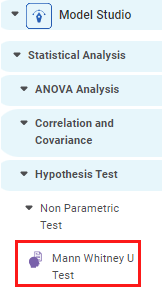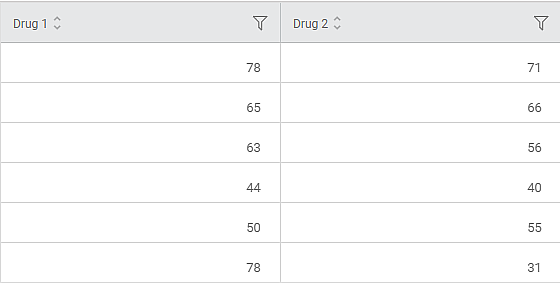Description |
| ||
Why to use | To determine if the population median of the two groups differs or not. | ||
When to use | When the dependent variable is continuous but not normally distributed. | When not to use |
|
Prerequisites |
| ||
Input | Two numeric data groups. | Output |
|
Statistical Methods Used |
| Limitations | The difference in sample sizes results in reduced power of the statistical test. |
Mann Whitney U Test is located under Model Studio ( ) in Statistical Analysis below Hypothesis Test, under Non-Parametric Test in the left task pane. Use the drag-and-drop method or double-click to use the algorithm in the canvas. Click the algorithm to view and select different properties for analysis.
The system calculates the p value in this test and compares it with the alpha value.
Criteria | Interpretation |
|---|---|
When the p-value is greater than alpha an alternative hypothesis can either be "Two-sided" or "One-sided (less than)" or "One-sided (greater than)" | As the p-value is greater than alpha, the population median of the first group equals the population median of the second group. (η1=η2) |
When the p-value is less than alpha and the alternative hypothesis is equal "Two-sided" | As the p-value is less than or equal to alpha, the population median of the first group is not equal to the population median of the second group. (η1≠η2) |
When the p value is less than alpha and the alternative hypothesis is equal "One-sided (less than)" | As the p value is less than or equal to alpha, the population median of the first group is less than the population median of the second group. (η1<η2) |
When the p value is less than alpha and the alternative hypothesis is equal to "One-sided (greater than)" | As the p value is less than or equal to alpha, the population median of the first group is greater than the population median of the second group. (η1>η2) |
Properties of Mann Whitney U Test
The available properties of the Mann Whitney U Test are shown below.
The table below describes the different properties of the Mann Whitney U Test.
Field | Description | Remark | |
|---|---|---|---|
Task Name | It is the name of the task selected on the workbook canvas. |
| |
Group 1 | It allows you to select the independent variable. |
| |
Group 2 | It allows you to select the independent variable. |
| |
Advanced | Continuity | It tells if a continuity correction should be applied or not. |
|
Alpha | It allows you to enter the alpha value or a significance level |
| |
Alternative | Defines the alternative hypothesis. |
| |
Node Configuration | It allows you to select the instance of the AWS server to provide control over the execution of a task in a workbook or workflow. | For more details, refer to Worker Node Configuration. | |
Example of Mann Whitney U Test
As a medical researcher, you wish to compare two independent drugs, Drug 1 and Drug 2 on their level of effectiveness. You use the Mann Whitney U test to determine whether the two drugs differ in their effectiveness.
The data tab shows the selected input columns. These are the two numeric data groups that are used for the comparison.
Further, the Result page is as follows.
The result page consists of the following sections:
1. Hypothesis:
This section displays Null Hypothesis and Alternative Hypothesis defined by the system.
2. Mann Whitney U Test:
This section displays the Mann Whitney U Test Rank test result. It shows value of the U Statistic, p Value and Alpha (α).
3.Interpretation:
In this example, the p value (0) is less than the alpha value (0.05); hence the null hypothesis is rejected. The rejection of the null hypothesis means that the population median of the first group differs from that of the second group.
Table of Contents





